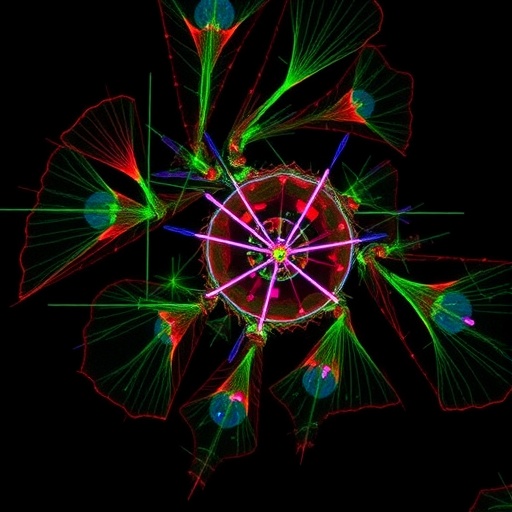At the microscopic scale, the challenge of discerning individual components within a blurred cluster has long intrigued scientists. Just as a pond’s chorus of croaking frogs blends into a collective sound impossible to separate without careful listening, a diffraction-limited spot in fluorescence microscopy represents a composite signal of multiple fluorescent molecules that traditional methods struggle to unravel individually. A novel approach developed by the Funke Lab at Janelia brings a transformative solution to this intricate problem by leveraging advanced Bayesian modeling paired with machine learning, enabling unprecedented resolution in counting molecular constituents within a single diffraction-limited spot.
Fluorescence microscopy is a cornerstone technique for visualizing biomolecules within living systems, but it suffers from fundamental physical constraints. When numerous fluorescent molecules localize so closely that their emitted light overlaps, the microscope captures a single bright spot rather than discrete signals from each emitter. The inability to directly observe individual molecules hinders quantitative analyses crucial for understanding complex biological processes. This new method—named blinx—circumvents these limitations by interpreting fluctuations in brightness over time, analogous to discerning individual frog croaks from the total volume of a pond’s chorus.
The concept hinges on the intrinsic blinking behavior of fluorescent molecules. Fluorophores do not emit photons at a constant rate; instead, their emission can switch stochastically between bright and dark states. This dynamic “blinking” creates temporal intensity variations within the combined spot. By capturing these intensity traces over time and mathematically modeling their origin, the researchers devised a strategy to backtrack from the observable fluctuations to decode the number of emitters and their properties, even when individual molecules cannot be spatially resolved.
Integral to this breakthrough was a comprehensive physical model of the optical pathway—from photon emission at the molecule to the formation of the diffraction-limited spot at the detector. The Funke Lab’s team meticulously accounted for myriad parameters, such as photon statistics, fluorophore photophysics, optical aberrations, and detection noise characteristics, to simulate realistic intensity traces contingent on both known and unknown system variables. This holistic approach ensured that the modeling encapsulates the complexity of real experimental data, providing robust grounds for subsequent inference.
The innovation lies in combining this physical model with a Bayesian machine learning framework, which allows for probabilistic inference rather than a single-point estimate. Rather than distinctly stating, "There are N molecules," blinx evaluates the likelihood of all possible numbers of fluorophores given the observed intensity trace. This probabilistic output empowers researchers to understand the confidence bounds of their measurements and identifies scenarios where data may be insufficient to yield conclusive counts, thus promoting cautious, data-driven interpretations.
By fitting their model to experimental intensity time series from fluorescence microscopy imaging, the researchers achieved highly accurate estimations of molecular counts even in spots containing dozens of closely packed emitters. This surpasses previous methodologies that often faltered under crowded conditions or yielded less informative single-number answers without confidence assessments. The increased accuracy and confidence quantification significantly enhance the reliability of molecule counting experiments critical to cellular and molecular biology.
The implications of blinx stretch well beyond mere counting. Since proteins comprise specific combinations and quantities of amino acids, precisely enumerating individual fluorescently labeled amino acid residues could pave the way for identifying protein composition or conformational states within complex mixtures. This could revolutionize approaches in proteomics, enabling more nuanced biochemical characterizations without necessitating spatial separation or complex sample preparations.
Furthermore, the method’s Bayesian nature enables a transparent communication of uncertainty, a feature critically lacking in many typical super-resolution analyses. Jan Funke, Group Leader at Janelia, emphasizes this honesty in reporting, stating that sometimes the available data simply do not support a definitive answer, and blinx’s ability to convey that ambiguity is a significant advancement in the field.
The inception and success of blinx owe much to the multidisciplinary environment at Janelia Research Campus. Alex Hillsley, who led the project during his postdoctoral tenure, notes that integrating expertise in chemistry, super-resolution imaging, and sophisticated modeling was essential in overcoming the multifaceted challenges posed by this ambitious endeavor. Such synergy exemplifies how collaborative scientific ecosystems can nurture pioneering techniques that single-discipline efforts might fail to achieve.
Looking forward, the developers envision blinx as a foundational tool adaptable and improvable by the scientific community. Because it does not rely on rigid assumptions but instead flexibly interprets fluorescence dynamics through a probabilistic lens, blinx sets the stage for newer generations of computational algorithms in microscopy and molecular imaging. Its open framework encourages others to optimize, extend, and customize the approach for diverse applications.
In the rapidly evolving field of microscopy and molecular quantitation, blinx marks a pivotal step. It transitions the paradigm from raw image intensity to statistically sound inferences about molecular populations. This not only enhances experimental rigor but also opens new investigative avenues to decode biological complexity at the nanoscale. As researchers adopt and refine blinx, we can anticipate a profound impact on how molecular interactions and structures are visualized, quantified, and ultimately understood.
This blend of advanced physics, cutting-edge computational modeling, and biological relevance exemplifies the kind of innovation needed to push the frontiers of science. With blinx, the frothy noise of molecular chatter is no longer a barrier but a rich source of information, waiting to be decoded by algorithms that listen as keenly as human ears longing to distinguish the croaks of individual frogs in a pond.
Subject of Research: Fluorescence microscopy, molecular counting, Bayesian modeling, super-resolution imaging.
Article Title: A Bayesian Model to Count the Number of Two-State Emitters in a Diffraction Limited Spot
News Publication Date: 4-Apr-2025
Web References:
https://pubs.acs.org/doi/10.1021/acs.nanolett.4c06304
References:
Funke Lab, Janelia Research Campus; Hillsley et al., Nano Letters (2025)
Keywords:
Mathematical modeling, Fluorescence microscopy, Molecular counting, Bayesian inference, Super-resolution imaging




